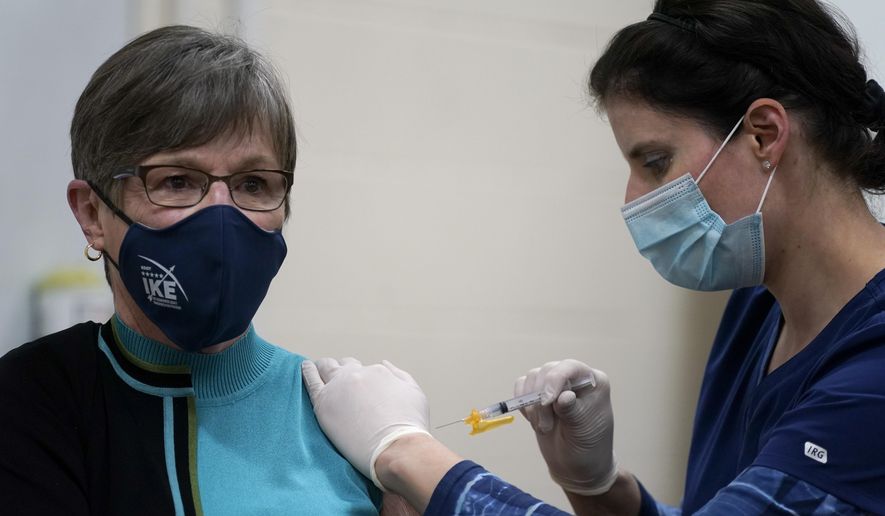TOPEKA, Kan. (AP) - Kansas ranks last among states in its reported COVID-19 vaccination rate, according to U.S. government data, and state officials attribute it to a lag in reporting by providers of the shots.
The federal Centers for Disease Control and Prevention reported that 12,164 people had received the first of two vaccine doses in Kansas as of Wednesday, or 418 for every 100,000 of its 2.9 million residents. The CDC said Kansas had administered less than 11% of the vaccine doses it had received.
Only Georgia, Mississippi and Ohio also had vaccination rates below 500 people per 100,000 residents, according to the CDC. Missouri’s rate was 1,084 shots for every 100,000 residents, and West Virginia led states with 2,178 per 100,000 residents.
The figures sparked new criticism of Democratic Gov. Laura Kelly’s handling of the coronavirus pandemic from the Republican-controlled Legislature after months of conflict between her and top GOP lawmakers. She plans to push legislators to rescind local control over mask mandates and restrictions on businesses after they convene their annual session Jan. 11, but Republicans are likely to resist.
House Majority Leader Dan Hawkins, a Wichita Republican, called the state’s low reported vaccination rate “truly disappointing.”
“People are seeking a return to normalcy, and Governor Kelly’s new normal isn’t going to cut it,” he said in a text to The Associated Press.
But Ashley Jones-Wisner, a spokeswoman for the Kansas Department of Health and Environment, said Thursday that the vaccination numbers are not current because not all providers are fully trained on using a computer system for reporting inoculations.
“We hope that as this process moves forward, and everyone becomes trained, we will be able to share accurate numbers more readily,” she said in an email.
Across the nation, the race to vaccinate millions of Americans is off to a slower, messier start than public health officials and leaders of the federal government’s distribution program had expected. Kansas doesn’t expect vaccines to be available for all adults until the end of the spring.
State health department data showed that Kansas averaged 1,821 new confirmed and probable coronavirus cases and 33 additional COVID-19 deaths a day for the seven days ending Wednesday. Kansas has reported more than 222,000 cases and more than 2,700 deaths since the pandemic reached the state in early March. That’s one case for every 13 residents and one death for every 1,063.
The CDC said that as of Wednesday, about 115,000 vaccine does had arrived in Kansas, while Dr. Lee Norman, the state health department’s head, said Kansas would have nearly 184,000 doses by Friday, including second doses of a vaccine made by Pfizer for 24,000 people.
The state has yet to report its own data for how many shots have been given.
“We don’t have the exact number because it lags,” Norman said during a Statehouse news conference Wednesday. “The data lags because it has to get into our epidemiology tracking system. The same people that are doing the vaccinations are the ones putting in the data.”
The state’s vaccine distribution plan calls for first giving shots to health care workers, nursing home workers and nursing home residents, then first responders and other essential workers. But Kansas also has a “continuity of operations” plan for state government that led Kelly to get her first vaccine shot Wednesday and to offer shots to 10 other top state officials. State agencies plan vaccinate hundreds of their employees as well.
Norman got his first shot Thursday. Neither he nor Kelly had any reaction to the inoculations, their offices said.
But House Speaker Ron Ryckman Jr., an Olathe Republican, said it was “sad” to see Kelly take time for a shot when vaccinations aren’t going to “Kansans who need them the most.” Ryckman, who was briefly hospitalized with COVID-19 during the summer, passed on a chance to get an early vaccination.
“Leadership is about taking care of others first,” he said.
Meanwhile, a law enacted in June ends a state of emergency for the pandemic on Jan. 26 unless the Legislature acts. The deadline is expected to spark a battle over the governor’s authority.
Kelly imposed a statewide stay-at-home order for five weeks, until early May. Top GOP lawmakers saw her as too slow to reopen the economy afterward, and the law enacted in June gave counties the ability to opt out of orders she issued. Key Republicans said GOP lawmakers are unlikely to back off their position that local control is best.
When the governor announced her statewide stay-at-home order in early March, Kansas had reported six COVID-19 deaths and fewer than 300 coronavirus cases and was reporting no cases in 71 of its 105 counties.
But Kelly said in a recent AP interview that she does not regret taking aggressive action early because Kansas had to get more information about the virus. Other Democrats noted other states also closed businesses and schools.
“I don’t think we could have done any different,” Kelly said.
But Republicans contend Kelly acted too aggressively too early and seriously damaged the state’s economy.
“Did we need to be cautious? Absolutely,” said incoming Senate Majority Leader Gene Suellentrop, a Wichita Republican. “Did we need to be irrational? Hell no, and I think she was at that time, and I think it’s proven to be damaging to the state.”
___
Follow John Hanna on Twitter: https://twitter.com/apjdhanna




Please read our comment policy before commenting.